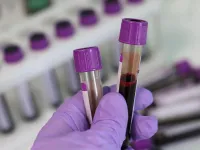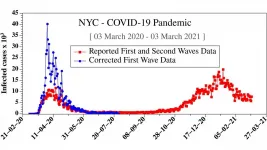(Press-News.org) Researchers have identified a combination of biological markers in patients with dengue that could predict whether they go on to develop moderate to severe disease, according to a study published today in eLife.
Biomarkers are used to identify the state or risk of a disease in patients. Examples of biomarkers can include naturally occurring molecules or genes in the vascular, inflammatory or other biological pathways. The new findings could aid the development of biomarker panels for clinical use and help improve triage and risk prediction in patients with dengue.
Dengue is the most common mosquito-borne viral disease to affect humans globally. In 2019, the World Health Organization identified dengue as one of the top 10 threats to global health, with transmission occurring in 129 countries and an estimated 3.9 billion people being at risk.
"While most symptomatic dengue infections are self-limiting, a small number of patients develop complications that usually occur at around four to six days from symptom onset," explains first author Vuong Nguyen Lam, Researcher and PHD Student at Oxford University Clinical Research Unit (OUCRU), Ho Chi Minh City, Vietnam. "Large numbers of patients therefore need regular assessments to identify these complications. The accurate and early identification of such patients, particularly within the first three days of illness, should allow for the appropriate care to be provided."
The role of blood biomarkers in predicting severe outcomes has been investigated in other studies, but mostly later in the disease progression or at hospital admission. Many of these biomarkers either peak too late in the disease course or have too short a half-life to be clinically useful.
To address this, Vuong and colleagues selected 10 candidate biomarkers from vascular, immunological and inflammatory pathways that are associated with dengue disease pathogenesis. These biomarkers were: VCAM-1, SDC-1, Ang-2, IL-8, IP-10, IL-1RA, sCD163, sTREM-1, ferritin, and CRP. They were chosen based on their likelihood to be increased during the early stages of disease.
The team then conducted a study using samples and clinical information from a large multi-country observational study called 'Clinical evaluation of dengue and identification of risk factors for severe disease' (IDAMS study). Of the 2,694 laboratory-confirmed dengue cases included in the IDAMS study, 38 and 266 cases were classified as severe and moderate dengue, respectively.
For the current study, the researchers selected 281 cases in four countries - Vietnam, Cambodia, Malaysia and El Salvador - as the blood samples from these participants were stored at the OUCRU laboratory. For comparison, the team also selected 556 patients with uncomplicated dengue who shared similar geographies and demographic characteristics.
They measured the participants' blood biomarkers at two different time points - one during the first three days of illness, and the second following recovery (10-31 days after symptom onset). They found that, during the first three days of illness, higher levels of any of the 10 biomarkers increased a patient's risk of developing moderate to severe dengue.
They also identified a combination of six biomarkers that was best associated with severe disease in children, and a combination of seven biomarkers that was best associated with severe disease in adults. "This highlights how relationships between biomarkers and clinical outcome can differ between age groups," Vuong says.
"Together, our findings should assist the development of biomarker panels to help improve future triage and early assessment of dengue patients," concludes senior author Sophie Yacoub, Dengue Research Group Head at OUCRU. "This would help improve individual patient management and healthcare allocation, which would be of major public health benefit especially in outbreak settings."
INFORMATION:
Media contact
Emily Packer, Media Relations Manager
eLife
e.packer@elifesciences.org
+44 (0)1223 855373
About eLife
eLife is a non-profit organisation created by funders and led by researchers. Our mission is to accelerate discovery by operating a platform for research communication that encourages and recognises the most responsible behaviours. We aim to publish work of the highest standards and importance in all areas of biology and medicine, while exploring creative new ways to improve how research is assessed and published. eLife receives financial support and strategic guidance from the Howard Hughes Medical Institute, the Knut and Alice Wallenberg Foundation, the Max Planck Society and Wellcome. Learn more at https://elifesciences.org/about.
To read the latest research in Medicine published in eLife, visit https://elifesciences.org/subjects/medicine.
And for the latest in Microbiology and Infectious Disease, see https://elifesciences.org/subjects/microbiology-infectious-disease.
About OUCRU
The Oxford University Clinical Research Unit (OUCRU) is a large-scale clinical and public health research unit based in Vietnam, Indonesia and Nepal. Our strategic aim is to have a positive and significant impact on global health and, in particular, the prevention, diagnosis and treatment of infectious diseases. OUCRU is one of five Wellcome Trust Major Overseas Programmes. Together with our partners, we have led a highly successful effort in enhancing the infrastructure and capacity to perform clinical trials and basic scientific research in Vietnam, Indonesia and Nepal. Our 10-year vision is to have a local, regional and global impact on health by leading a locally-driven research programme on infectious diseases in Southeast Asia.
The ancient Maya city of Tikal was a bustling metropolis and home to tens of thousands of people.
The city comprised roads, paved plazas, towering pyramids, temples and palaces and thousands of homes for its residents, all supported by agriculture.
Now researchers at the University of Cincinnati say Tikal's reservoirs -- critical sources of city drinking water -- were lined with trees and wild vegetation that would have provided scenic natural beauty in the heart of the busy city.
UC researchers developed a novel system to analyze ancient plant DNA in the sediment of Tikal's temple and palace reservoirs to identify more than 30 species ...
HOUSTON - (June 22, 2021) - How do you kill tumor cells that can't be targeted? Get their more susceptible neighbors to help.
The Rice University lab of synthetic chemist K.C. Nicolaou, in collaboration with AbbVie Inc., has created unique antibody-drug conjugates (ADCs) that link a synthetic uncialamycin analogue to antibodies that target cancer cells.
Once they enter the targeted tumor cells, these ADCs exhibit a "significant bystander effect," according to the study. In other words, cancerous neighbor cells that aren't directly attacked by the drugs are also affected.
The study in the Proceedings of the National Academy of Sciences presents "an intriguing opportunity ...
Researchers at the University of Cincinnati College of Medicine have developed a blueprint for a protein that plays an important role in the development and regulation of reproductive organs.
The knowledge advances our understanding of the protein anti-Müllerian hormone hormone (AMH), which helps form male reproductive organs and in females regulates follicle development and ovulation in the ovaries, explains Thomas Thompson, PhD, professor in the UC Department of Molecular Genetics, Biochemistry and Microbiology.
Scientists have been looking to regulate AMH because it might play a role in developing a novel contraceptive, aid in treatments for infertility ...
An enzyme found in fat tissue in the centre of our bones helps control the production of new bone and fat cells, shows a study in mice published today in eLife.
The findings may help scientists better understand how the body maintains fat stores and bone production in response to changing conditions, such as during aging. They may also suggest new approaches to treating conditions that cause bone loss in older adults.
Fat cells, including those found in the bone marrow, are increasingly recognised as an important part of the body that helps regulate body weight, insulin sensitivity and bone mass. Fat tissue ...
DETROIT - Jessica Damoiseaux, Ph.D., an associate professor with the Institute of Gerontology at Wayne State University, recently published the results of a three-year study of cognitive changes in older adults. The team followed 69 primarily African American females, ages 50 to 85, who complained that their cognitive ability was worsening though clinical assessments showed no impairments. Three magnetic resonance imaging scans (MRIs) at 18-month intervals showed significant changes in functional connectivity in two areas of the brain.
"An older adult's perceived cognitive decline could be an important precursor to dementia," Damoiseaux said. "Brain alterations that underlie the experience of decline could reflect ...
(Boston)--Lung cancer remains the leading cause of cancer-related deaths. Non-small cell lung cancer (NSCLC) accounts for 80-85 percent cases of lung cancer and when diagnosed early, has a five-year survival rate of 50-80 percent. Black patients have lower overall incidence of NSCLC than white patients, but are more likely to be diagnosed at later stages. They also are less likely to receive surgery for early-stage cancer.
Now a new study from Boston University School of Medicine (BUSM) highlights the impact that structural racism and residential segregation has on NSCLC outcomes.
The researchers analyzed patient data from the Surveillance, Epidemiology and End Results Program--a database of Black and white patients diagnosed with NSCLC from 2004-2016 in the 100 ...
PROVIDENCE, R.I. [Brown University] -- What motivated Americans to wear masks and stay socially distanced (or not) at the beginning of the COVID-19 pandemic? More often than not, it was partisanship, rather than perceived or actual health risk, that drove their behavior, according to a new study co-authored by researchers at Brown University.
By analyzing the results of two online surveys of more than 1,100 adults in total, Mae Fullerton, a Class of 2021 Brown graduate, and Steven Sloman, a professor of cognitive, linguistic and psychological sciences, found that in spring and fall 2020, political partisanship was the strongest predictor of whether someone ...
An analysis of survey data from more than 280,000 young adults ages 18-35 showed that cannabis (marijuana) use was associated with increased risks of thoughts of suicide (suicidal ideation), suicide plan, and suicide attempt. These associations remained regardless of whether someone was also experiencing depression, and the risks were greater for women than for men. The study published online today in JAMA Network Open and was conducted by researchers at the National Institute on Drug Abuse (NIDA), part of the National Institutes of Health.
"While we cannot establish that cannabis use caused the increased suicidality we observed in this study, these associations warrant further research, especially ...
What The Study Did: Researchers report their study found no association in SARS-CoV-2 positivity rates among health care workers wearing respirator masks compared with medical masks when performing nonaerosolizing routine patient care.
Authors: :Aldon Li, M.D., of the Southern California Permanente Medical Group in Riverside, California, is the corresponding author.
To access the embargoed study: END ...
WASHINGTON, June 22, 2021 -- Two COVID-19 pandemic curves emerged within many cities during the one-year period from March 2020 to March 2021.
Oddly, the number of total daily infections reported during the first wave is much lower than that of the second, but the total number of daily deaths reported during the first wave is much higher than the second wave.
This contradiction inspired researchers from the University of Nicosia in Cyprus to explore the uncertainty in the daily number of infections reported during the first wave, caused by insufficient contact tracing between March and April 2020.
In Physics of Fluids, ...





